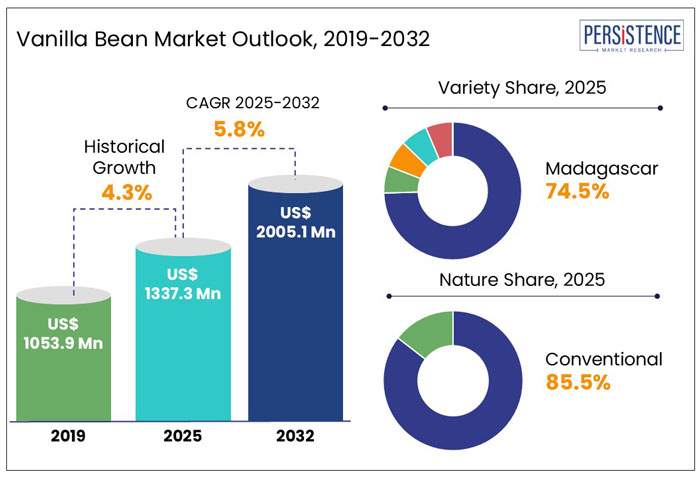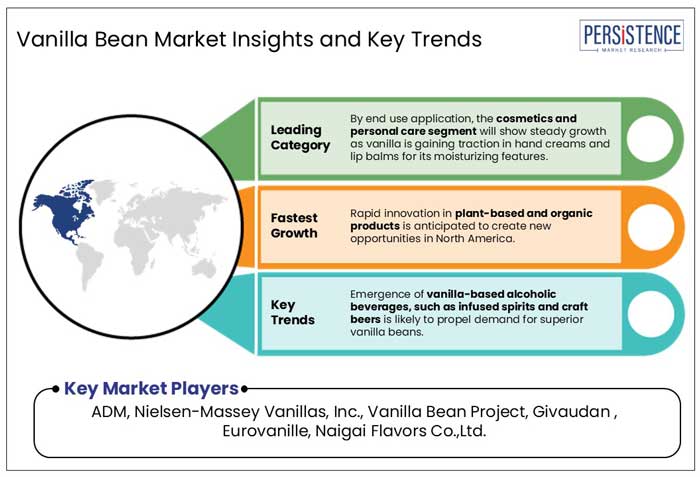Industry: Food and Beverages
Published Date: March-2025
Format: PPT*, PDF, EXCEL
Delivery Timelines: Contact Sales
Number of Pages: 187
Report ID: PMRREP21652
The global vanilla bean market is estimated to rise from US$ 1,337.3 Mn in 2025 to US$ 2,005.1 Mn by 2032. The market is projected to record a CAGR of 5.8% during the forecast period from 2025 to 2032.
Persistence Market Research anticipates that sustainability efforts and developments in cultivation practices are shaping market dynamics, creating growth opportunities for ethical sourcing and traceability initiatives. For instance,

Key Highlights of the Vanilla Bean Industry
|
Global Market Attributes |
Key Insights |
|
Vanilla Bean Market Size (2025E) |
US$ 1,337.3 Mn |
|
Market Value Forecast (2032F) |
US$ 2,005.1 Mn |
|
Projected Growth (CAGR 2025 to 2032) |
5.8% |
|
Historical Market Growth (CAGR 2019 to 2024) |
4.3% |
Rising Global Shipping Costs Surged Vanilla Transportation Expenses in Historical Period
The global vanilla bean market witnessed a CAGR of 4.3% in the historical period between 2019 and 2024. The COVID-19 pandemic impacted production, supply chains, and demand dynamics. Lockdowns in key vanilla-producing regions, particularly Madagascar, resulted in labor shortages, harvesting delays, and logistical challenges. Travel restrictions further limited workforce mobility, while rising global shipping costs increased the expense of transporting vanilla to international markets, such as Japan. For example,
Although short-term logistical challenges caused delays, the export market proved to be resilient. The industry’s ability to adapt to supply chain disruptions ensured continued exports, reinforcing vanilla’s importance in the global food industry.
Vanilla to Remain a Crucial Ingredient in Global Food and Beverage Industry, Boosting Demand for Beans
The market is anticipated to rise at a CAGR of 5.8% between 2025 and 2032. Growing preference for clean labels and organic products will likely drive demand for real vanilla over synthetic substitutes.
Booming market for luxury bread, confectionery, dairy, and beverage items is anticipated to bolster its significance. Furthermore, developments in plant-based and health-conscious products will likely ensure vanilla's continued importance as a vital flavoring ingredient worldwide, thereby bolstering demand for vanilla beans.
Growth Drivers
Vanilla Beans to be Demanded as Use of Vanilla Rises in Pharmaceuticals and Cosmetics
Vanilla, long celebrated for its rich, soothing fragrance and distinctive flavor, is experiencing a surging demand across multiple industries. Its use is no longer confined to the culinary world. Vanilla is increasingly being preferred in cosmetics, pharmaceuticals, and even traditional medicine, making it a key driver for the global vanilla bean market.
In the cosmetics industry, vanilla's luxurious scent is desired in perfumes, lotions, soaps, and skincare products. The ingredient is essential in creating soothing and aromatic experiences, and its presence is found in 23% of all high-quality perfumes.
High-end perfumes often contain vanilla absolute, while more affordable fragrance brands opt for synthetic vanilla oils. As consumers increasingly seek natural and calming fragrances in beauty products, demand for vanilla continues to rise.
In pharmaceuticals, vanilla plays a key role as a flavoring agent. It is commonly used in syrups, chewable tablets, suspensions, and gums to mask or improve the taste of medications, making these more palatable. Studies have highlighted vanillin’s neuroprotective, antioxidant, and anticancer elements, contributing to its rising popularity in the pharmaceutical sector. For instance,
Such findings are anticipated to help extend vanilla’s use beyond flavoring, positioning it as a promising bioactive compound in medicine, thereby driving demand for vanilla beans.
Climate Change-induced Extreme Weather Conditions to Reduce Supply
Vanilla’s pricing remains highly volatile due to political, economic, and environmental factors continuously disrupting supply and demand. Political instability in key producing regions, particularly Madagascar, can lead to export restrictions, currency fluctuations, and unpredictable government interventions, which further impact pricing.
Government-imposed price controls, trade barriers, and diplomatic tensions can artificially inflate prices or create market imbalances, making it difficult for farmers and buyers to operate smoothly. Additionally, economic inequality and corruption in some vanilla-growing regions complicate the market, often benefiting large corporations while small-scale farmers struggle to compete.
Climate change further exacerbates vanilla’s pricing instability. Extreme weather conditions, including cyclones, droughts, and unseasonal rainfall, destroy entire harvests, drastically reducing supply. For example, the 2017 cyclone in Madagascar wiped out a significant portion of the country’s vanilla crop.
Vanilla plants are also highly susceptible to pests and diseases, such as Fusarium wilt and root rot. These often decimate plantations and compel farmers to abandon or replant crops, leading to further delays in production.
Emergence of Microwave-assisted Extraction and Precision Fermentation to Spur Developments
Technological developments and strategic partnerships are unlocking new opportunities for innovation in the vanilla bean industry, driving efficiency, sustainability, and enhanced flavor profiles. For instance,
Integration of innovative extraction methods, such as microwave-assisted extraction and precision fermentation, has streamlined the vanilla production process. It is reducing both energy consumption and time, while improving the quality of vanilla.
Innovative approaches like Microwave-Assisted Extraction (MAE), utilized by companies like Metarom, revolutionize vanilla processing by significantly reducing extraction time and energy consumption compared to traditional methods. This technique uses microwave energy to heat vanilla beans uniformly, releasing flavor compounds quickly and efficiently.
End Use Application Insights
Premium Dairy Brands Leveraging Madagascar Bourbon Vanilla for Authentic Taste Experience
In terms of end use application, the cosmetics and personal care segment is projected to witness steady growth through 2032. Due to its medicinal, skincare, and aromatic properties, vanilla is essential to the personal care and cosmetics industries. It is a sought-after ingredient in several beauty and personal care formulas due to its natural origin, strong antioxidant and vitamin composition, and calming properties.
Because of its well-known calming and moisturizing qualities, vanilla extract is frequently found in hand creams, lip balms, and body lotions. Particularly in products for dry and sensitive skin, it soothes inflamed skin and offers deep nourishment. Vanilla is widely utilized in personal care, as evidenced by the entire product lines of companies like Bath & Body Works and The Body Shop that are focused on moisturizers with this aroma.
In the dairy industry, on the other hand, vanilla beans play a significant role by enhancing sensory experience, improving texture, and adding natural flavor to several dairy-based products.
Around 30% of all ice cream sales are of vanilla, making it the most popular ice cream flavor in the world. Vanilla beans' rich texture is complemented by their creamy, sweet, and slightly flowery aromas, which makes them a popular base flavor and a common ingredient in high-end and artisanal ice creams. Premium products like Häagen-Dazs and Ben & Jerry's frequently employ Madagascar Bourbon vanilla, which has a deep, creamy flavor, to add a genuine, natural flavor.
Type Insights
High Vanillin Content in Madagascar Vanilla Driving Its Preference in Premium Culinary and Cosmetic Applications
Madagascar's rich flavor profile, stable supply, and exceptional quality make their vanilla beans the most sought-after in the world. The segment will likely hold 74.5% share in 2025.
More than 80% of the world's vanilla is produced in Madagascar, especially in the Sava region, making it the industry leader. The remarkable qualities of the nation's vanilla beans distinguish them from other types due to its distinct climate, traditional curing techniques, and strict quality control.
Because of their high content of vanillin, which intensifies their aromatic depth, Madagascar vanilla beans are highly valued. For example,
Madagascar vanilla is considered the ideal option for upscale culinary applications, as well as for the pharmaceutical and cosmetics industries who need natural vanilla extracts due to their greater vanillin content. Madagascar vanilla is used in the compositions of high-end perfumes by companies like Chanel and Jo Malone because of its rich, enduring scent.
Tahitian vanilla beans, on the other hand, are gaining impetus owing to their unique fruity and floral flavor profile. Tahitian vanilla is establishing a luxury niche, especially in the gourmet food, fine fragrance, and personal care industries, but Madagascar vanilla still controls most of the market.
Compared to Bourbon vanilla, Tahitian vanilla has a stronger floral scent due to its higher percentage of heliotropin (piperonal). In the perfume and personal care sectors, where scent richness and longevity are highly prized, this has led to its growing popularity.

Middle East and Africa Vanilla Bean Market
Rising Vanilla Cultivation in Comoros and Uganda Strengthening Africa’s Market Share
With Africa as a leading producer and the Middle East as a developing consumer, the Middle East and Africa is significant to the global vanilla bean industry. With an estimated 3,227.93 metric tons produced in 2022, Madagascar and Africa rank among the world's top producers of vanilla beans, accounting for a sizeable amount of the world's supply.
Comoros and Uganda, two other African nations that have become significant producers, produced around 240.33 metric tons and 187.13 metric tons in 2022, respectively. That year, 3,506.17 metric tons of vanilla were produced in Africa, making up 45.5% of the world's total production. Africa is a key source in the world's vanilla trade because of the region’s ideal tropical environment, which makes vanilla cultivation possible.
North America Vanilla Bean Market
Legal Scrutiny on Artificial Flavoring Reinforcing Preference for Pure Vanilla Sources in North America
North America is anticipated to hold 21.2% of the global vanilla bean market share in 2025. It is projected to rise due to the presence of several key food and beverage manufacturers in the U.S. and Canada. Rapid innovation in plant-based and organic products is another key factor estimated to surge demand for vanilla. Furthermore, shifting culinary trends contributes to North America's dominance in vanilla bean consumption.
Stringent food and beverage safety norms in the U.S. is further set to compel manufacturers to extract vanilla from beans rather than artificial or synthetic sources. For instance,
South Asia and Oceania Vanilla Bean Market
Favorable Climatic Conditions Supporting Vanilla Cultivation in South Asia and Oceania
South Asia and Oceania will likely witness 7.3% CAGR from 2025 to 2032. The region is projected to see significant developments in the market due to favorable atmospheric conditions for vanilla cultivation. For example,
Emerging areas across Papua New Guinea and India are also likely to broaden production. Strong government backing for agricultural exports is another significant opportunity in the region.
The region's booming bakery and confectionery industry, driven by the desire for quality and natural ingredients, also contributes to increased vanilla consumption. Emerging vanilla-growing nations, such as Sri Lanka and Indonesia, are increasing supply, positioning South Asia and Oceania as key hubs in the global market.
The vanilla bean industry is moderately consolidated, with key players holding 40% to 50% of the total share. E-commerce is critical in extending the market reach, offering consumers easy access to premium vanilla products. Leading brands are focusing on direct sourcing partnerships, sustainable farming, product differentiation, and digital marketing strategies to strengthen their presence and gain a competitive edge.
Governments are also taking initiatives to broaden vanilla cultivation in tropical regions. For instance, the U.S. Department of Agriculture’s Food for Progress Uganda program funds the Vines Project. It involves a US$ 13 Mn investment aimed at improving vanilla-based agroforestry, creating jobs, and supporting over 16,000 Ugandan vanilla farmers.
Key Industry Developments
|
Report Attributes |
Details |
|
Historical Data/Actuals |
2019 - 2024 |
|
Forecast Period |
2025 - 2032 |
|
Market Analysis Units |
Value: US$ Bn/Mn, Volume: As Applicable Volume: Tons |
|
Geographical Coverage |
|
|
Segmental Coverage |
|
|
Competitive Analysis |
|
|
Report Highlights |
|
|
Customization and Pricing |
Available upon request |
By Variety
By Nature
By End Use Application
By Region
To know more about delivery timeline for this report Contact Sales

The market is estimated to be valued at US$ 1,337.3 Mn in 2025.
Rising need for natural vanilla in food and beverages is a key demand driver.
Madagascar is considered to be one of the largest producers of vanilla beans.
Madagascar vanilla bean is the most popular variety globally.
ADM, Nielsen-Massey Vanillas, Inc., Vanilla Bean Project, Givaudan, Eurovanille, and Naigai Flavors Co., Ltd are a few leading players.